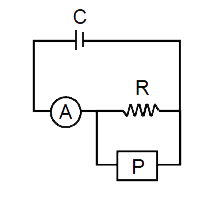An ammeter and a voltmeter are joined in series to a cell. Their readings are A and V respectively. If a resistacne is now joind in parallel with the voltmeterSolution in Punjabi
both A and V will increase
both A and V will decrease
A will decrease and V will increase
A will increase and V will decrease.
Step by step video & image solution for An ammeter and a voltmeter are joined in series to a cell. Their readings are A and V respectively. If a resistacne is now joind in parallel with the voltmeter by Physics experts to help you in doubts & scoring excellent marks in Class 12 exams.
Updated on:21/07/2023Topper's Solved these Questions
Similar Questions
For current entering at A, the electric field E(r at a distance r form A
View SolutionDefine atomic number.
View SolutionA charge q is placed at the centre of line joining two equal charges Q. Show that the system of three charges will be in equilibrium if q = -Q/4
View SolutionAn ammeter and a voltmeter are joined in sereis to a cell. Their readings are A and V respectively. If a resistance is now joinding parallel with the voltmeter. Then
View SolutionAn ammeter A of finite resistance, and a resistor R are joined in series to an ideal cell C. A potentiometer P is joined in parallel to R. The ammeter reading is I0 and the potentiometer reading is V0. P is now replaced by a voltmeter of finite resistance. The ammeter reading now is I and the voltmeter reading is V.

View SolutionA voltmeter and an ammeter are joined, in series to an ideal cell, giving reading V and A respectively. If a resistance equal to the resistance of the ammeter is now joined in parallel to the ammeter then :
View SolutionAn ammeter and a voltmeter are joined in sereis to a cell. Their readings are A and V respectively. If a resistance is now joinding parallel with the voltmeter. Then
View SolutionAn ammeter A of finite resistance , and a resistor R are joined in series to an idel cell C.A potentiometer P is joined in parallel to R. The ammeter reading is I0 and the potentiometer reading is V0. P is now replaced by a voltmeter of finite resistance . The ammeter reading now is I and the voltmeter eading is V.

View SolutionAn ammeter, voltmeter and a resistor are connected in series to a cell and the readings are noted as I and V. If another resistor R is connected in parallel with a voltmeter, then
View SolutionR प्रतिरोध के एक वोल्टमीटर तथा नगण्य प्रतिरोध के अमीटर को एक नगण्य आंतरिक प्रतिरोध के विद्युत सेल के श्रेणीक्रम में संयोजित किया जाता है अमीटर तथा वोल्टमीटर का पाठ्यांक क्रमशः A तथा है V यदि एक R प्रतिरोध वोल्टमीटर के समान्तर क्रम में जोड़ा जाता है तो A तथा V के मानो पर क्या प्रभाव पड़ेगा ?
View SolutionAn ammeter and a voltmeter are joined in series to a cell. Their readigns are A and V respectively. If a resistance is now joined in parallel with the voltmeter, then
View Solutionएक अमीटर व एक वोल्टमीटर एक सेल के साथ श्रेणीक्रम में जोड़े जाते हैं। उनके पाठ्यांक क्रमशः A व V है । प्रतिरोध, वोल्टमीटर के साथ समान्तर क्रम में जोड़ा जाता है:
View SolutionAn ammeter A of finite resistance, and a resistor R are joined in series to an ideal cell C. A potentiometer P is joined in parallel to R. The ammeter reading is I0 and the potentiometer reading is V0 . P is now replaced by a voltmeter of finite resistance. The ammeter reading now is I and the voltmeter reading is V.

View SolutionAn ammeter and a voltmeter are j oined in series to a cell. Their readings are A and V respectively. If a resistance is now joined in parallel with the voltmeter
View SolutionAn ammeter of finite resistance and resistor R are connected in series to an ideal cell. The voltmeter wire P is connected in parallel with R. Ammeter and voltmeter wire reading respectively I_(0) And V_(0) is. P is replaced by a voltmeter of finite resistance. Now the reading of ammeter and voltmeter are I and V respectively.
View SolutionAn ammeter and a voltmeter are joined in series to a cell. Their readings are A and V respectively. If a resistance is now joining parallel with the voltmeter. Then
View Solution
